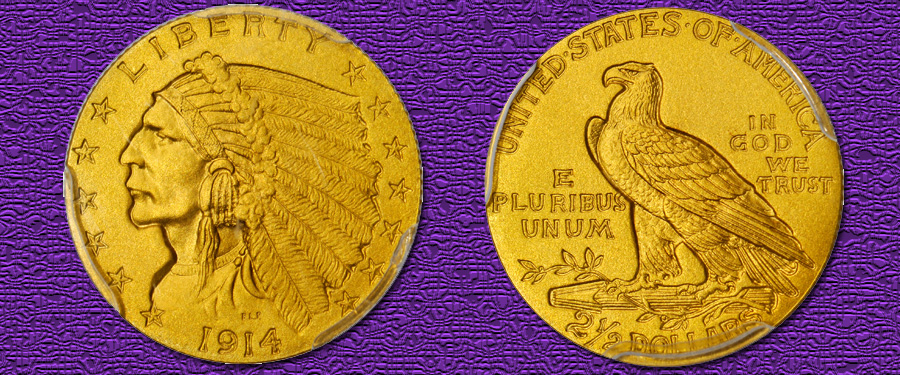
To
be offered in the Rarities Night session of our Official Auction of the ANA
World’s Fair of Money in August is a gorgeous Matte Proof 1914 Indian quarter
eagle that ranks among the finest examples known. Whereas Proofs of the
preceding Liberty design had featured either a cameo or all-brilliant finish,
the Proofs of the Indian quarter eagles, half eagles and Saint-Gaudens double
eagles were prepared using satin-finish dies, and were usually sand blasted
after striking to provide a heavy, coarse-grain finish. Although a radical
departure from tradition at the U.S. Mint, this technique had already seen
widespread use in Europe by the early 20th century. Additionally, the U.S. Mint
had used this finish on certain medals during the later years of the 19th
century.
In
anticipation of strong sales linked to the new design type, the Philadelphia
Mint struck 236 Proof 1908 quarter eagles. While enough specimens were ordered
and preserved by the contemporary public to make the 1908 the most plentiful
Proof Indian two-and-a-half in today’s market, the sand blast finish came as a
shock to many and sales fell short of the Mint’s prediction. Probably at least
one third of the mintage was eventually melted as unsold. Recognizing the
unpopularity of the coarse-grain sand blast finish, the Mint altered its method
of manufacture for the 1909 issue. The 1909, with a mintage of 139 Proofs, featured
a more vibrant satin finish that numismatists have traditionally referred to as
"Roman Finish." Proof 1909 quarter eagles were also struck with
special dies on specially prepared planchets but, unlike their sand blast
predecessors of 1908, were not treated to that post-striking finish. As a
result examples of this issue retain the original bright satin texture imparted
by the dies.
Although
conceived as an aesthetic improvement over its sand blast predecessor, the
satin finish proved equally unpopular with contemporary collectors, many of
whom believed that the coins were too similar in appearance to circulation strikes.
Despite this, the Mint continued with the satin finish for the Proof 1910
quarter eagles, returning to the sand blast Proof technique in 1911 only after
enthusiasm had further plummeted.
Although
this finish remained in use through the end of the Proof Indian quarter eagle series
in 1915, each of these later date issues exhibits subtle differences in color
and texture, with the 1914 issue typically displaying olive shades as is true
of the present jewel.
The
Superb Gem we will be offering in our August ANA auction exhibits a rich
honey-wheat complexion with hints of green-gold toning. The surfaces are
virtually flawless, revealing shimmering facets and unbroken satiny luster. As
would be expected, the strike is sharp throughout, handsomely showcasing
Pratt’s iconic incuse motifs.
This
spectacular Sand Blast Proof rarity will be offered alongside numerous other
treasures in the Rarities Night session of our August 2016 ANA World’s Fair of Money
Auction in Anaheim, California. To consign your rarities to this showcase
event, please contact our offices today at 1-800-458-4646 to speak with a
Consignment Director and see what Stack’s Bowers Galleries can do for you.





